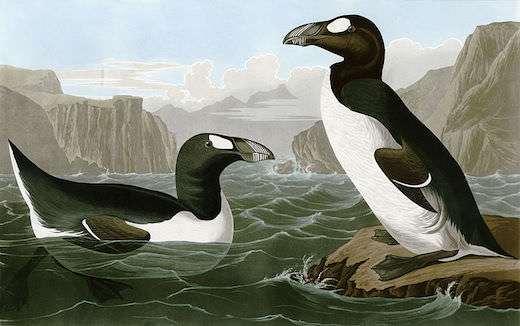Great Auk

Extinct 1852
While today we’ve grown comfortable with penguins, and their unique characteristics, at one time they weren’t so unique. Despite not being related to the penguin in any way, the Great Auk was a bird that, much like the penguin, could not fly due to its minimal wingspan. It was the first bird to actually be given the name penguin despite this, and over time the penguin has since taken over the name.
The Great Auk was typically anything from 75-85cm in height, and could weigh up to 11lbs. This comfortably makes it the heaviest member of the alcid line of birds. Carrying the same black back and white body of the penguin, it differed by having a large beak which was slightly hooked. Both eyes also had quite striking white patches surrounding them. These patches would vanish in the winter, though, and is replaced by a white band which ran between both eyes. The bird itself at one stage held a significance among many Native American tribes and cultures. For example, back in the time of the Maritime Archaic peoples, they would all be buried alongside the bones of a Great Auk.
Habitat
Typically found towards the North Atlantic, typically along coastal areas of the north-east US and Canada, this was a breed of animal that got around quite considerably. It was commonly seen in places like Iceland, Norway, the Faroe Islands and even places like north Spain, France and the UK! In fact, cave paintings that are at least 35,000 years old in the north of Spain depict these comical animals.
One of the biggest breeding areas was found in the Orkney Islands, and another popular breeding site was found to be just off Scotland’s coast, at St.Kilda.
Typically, they left the North Atlantic purely to breed and when they weren’t mating they would be comfortably perched on rocky island formations. The bird craved simple access to the sea, so they tended to stay on rocky formations that kept them safe, whilst allowing for simple entry back into the water via a shore. Because of their clumsiness on land, they made up for this by spending a lot of time swimming from island to island.
Reason for Extinction
As many other animals have been, they acted as a food source for people more than 100,000 years ago. They were hunted during the winter quite mercilessly by Natives looking for something to eat, and this began the heralding of the bird as a symbol of sorts. The Beothuks, now extinct themselves, made pudding from their eggs.
They were hunted basically everywhere they tended to be, either for food or for fashion. For example, the Maritime Archaic people tended to wear combinations of the Auk as some form of cloak for warmth.
The biggest reason, though, was because of the down that the animals had so prominently. They were used to make pillows in Europe, contributing massively to their extinction in Europe. They became the choice of down in the late 1770s in North America, effectively sealing their fate. The last colony of great auks that ever lived were found not far from Iceland. To make things worse, the last ever Auk was strangled to death by Jon Brandsson and Sigurdur Isleifsson.